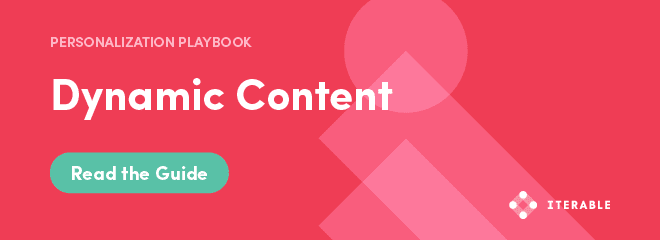Remember the last time you received a promotional email that started with your first name? Did the inclusion of your first name really affect your experience that much?
“{{first name}}, check out these products you’ve never previously shown interest in!” Despite the address, this type of personalization doesn’t build a longer-term relationship with users if you’re not also providing relevant information to them.
This is where dynamic content comes in to take you from personalization to individualization. Today’s consumers are looking for an experience that shows marketers are paying attention to them. They want brands to use data in a way that creates a memorable experience.
Without dynamic content, an inherent formality between the brand-customer relationship remains.
Charting the Path to Personalization
We did it, folks. We’ve officially reached the final pillar in our Core 4 pillars of personalization.
- User Segmentation
- Lifecycle Mapping
- Workflow Building
- Dynamic Content
After perusing all three playbooks linked in the list above, check out our Personalization Maturity Model to test your own personalization preparedness!
But for now, let’s take a quick look at what’s in store for the last chapter of our series.
Introducing Our Dynamic Content Personalization Playbook
In our Personalization Playbook on Dynamic Content, we walk you through the types of data needed to take your messaging from personalization to individualization. From there, we take you through a few tools that help turn your data into an optimal customer experience.
Download the full playbook here! Or if you’re not convinced yet, here’s a glimpse inside.
The Four Types of Data You Need to Create Dynamic Content
Let’s talk about the four types of data you need to create dynamic content in your messaging:
- User attributes
- Event data
- External data
- Metadata
We’ll go through each type individually, with examples to illustrate.
1. User Attributes
User attributes are the demographic and personal information you have on each and every one of your customers. Think of information like their first and last name, birthday, email address, and the date they subscribed to your list.
Typically, user attributes are submitted through a Manage Subscriptions or User Preferences page, like the one clothing retailer Mashburn uses below.


Clothing retailer Mashburn asks customers whether they want to receive emails about their men’s line, women’s line, or both.
Let us be clear: Brands need user attributes to do the bare minimum of personalization. However, relying exclusively on this date type has limits on how tailored your messaging can get, because it’s the customer’s responsibility to supply you with their information.
You know that idiom of “actions speaking louder than words?” That’s when personalization gets a little more interesting, with our next data type.
This is just a sneak peek of what’s in the full playbook. Download it now to see the other three types of data you need to create dynamic content.
The Individualized Experience With Dynamic Content
Consumer expectations have changed. Base-level personalization just doesn’t cut it anymore when looking to build a better customer experience. You need dynamic content to stay relevant and individualize the experience for each customer. The first step in making dynamic content possible is identifying, collecting, and managing the key data and tools available.
In this short video, Iterable solutions consultant Nick Allen takes the principles of dynamic content and individualization and demonstrates how to execute them in Iterable. Using two hypothetical brands as examples, Nick shows how their experiences can be improved by properly utilizing different data types.
As you can see, dynamic content makes a personal connection possible. It allows you as the marketer to move into a new level of personalization that fosters a deeper relationship with the user.
With dynamic content driving messaging, you are opening the door for the customer’s behavior to lead their journey rather than trying to fit each customer into a predetermined path. It’s the type of fluid, dynamic relationship consumers desire.
Download the playbook to see how dynamic content can help you connect with customers at the individual level.
































